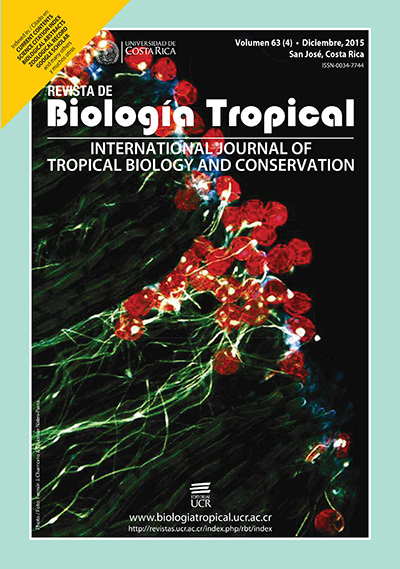Abstract
In argentinian Northwestern five species or biotypes of the genus Cactoblastis Ragonot are recognized on cacti: C. cactorum (Berg), C. Bucyrus Dyar, C. mundelli Heinrich, C. doddi Heinrich and C. ronnai (Brèthes). Cactoblastis doddi feeds on Opuntia sulphurea, a native cactus. The objectives of this study were to morphologically characterize immature stages of C. doddi and to know bioecological aspects (duration of the development, distribution, larval parasitoids) to understand the insect-plant interaction. Sampling were conducted at seven sites located at different altitudes (2 100-3 100 meters) in Jujuy’s prepuna, Argentina. Each sample consisted of five infested cladodes of O. sulphurea in each site. In the laboratory, lepidopteran breeding was performed under the following conditions: temperature 23 ± 3°C, relative humidity 69 ± 11 % and photoperiod of 12 hours light-12 hours dark. Under previous conditions, Cactoblastis doddi had two generations: a long one in winter (> 258 days) and a short one in summer (147 days), both with seven larval instars. Each immature stage and instars were morphologically characterized. Two larval parasitoids were detected Apanteles opuntiarum Martínez y Berta, and Habrobracon sp. (Hymenoptera: Braconidae). It confirms and extends the Argentinian distribution of C. doddi to Coraya, Jujuy (3 069 m).
References
Arce de Hamity, M. G., & Neder de Román, L. E. (1999). Bioecología de Cactoblastis bucyrus (Lepidoptera: Phycitidae), especie dañina al cardón Trichocereus pasacana en la Prepuna jujeña (Argentina). Revista de la Sociedad Entomológica Argentina, 58(3-4), 23-32.
Cabrera, A. L., & Willink, A. (1973). Biogeografía de América Latina. Washington, Estados Unidos: OEA
Cabrera, A. L. (1976). Enciclopedia Argentina de Agricultura y Jardinería. Buenos Aires, Argentina: Acme S.A.C.I.
Heinrich, C. (1939). The cactus- feeding Phycitinae: A contribution toward a revision of the american pyralidoid moths of the family Phycitidae. Proceedings of the United States National Museum, 86(3053), 354-361.
Hinton, H. E. (1946). On the homology and nomenclature of the setae of lepidopterous larvae, with some notes on the phylogeny of the Lepidoptera. Transactions of the Royal Entomological Society of London, 97, 1-37.
Kiesling, R. (1999). Cactaceae. In F. O. Zuloaga, & O. Morrone (Eds.), Catálogo de las Plantas Vasculares de la República Argentina II (pp. 423-489). Estados Unidos: Missouri Botanical Garden.
Legaspi, J. C., Baez, I., & Legaspi, B. (2009). Reproduction, longevity, and survival of Cactobastis cactorum (Lepidoptera: Pyralidae). Annals of the Enomological Society of America, 102(3), 45-449.
Mann, J. (1969). Cactus-feeding insects and mites. Bulletin of the Smithsonian Institution United National Museum, 256, 44-52.
Martínez, J. J., Berta, C., Varone, L., Logarzo, G., Zamudio, P., Zaldivar Riveron, A., & Aguilar Velasco, R. G. (2012). DNA barcoding and morphological identification of Argentine species of Apanteles (Hymenoptera: Braconidae), parasitoids of cactus-feeding moths (Lepidoptera: Pyralidae: Phycitinae), with description of a new species. Invertebrate Systematic, 26, 435-444.
McFadyen, R. E. (1985). Larval characteristics of Cactoblastis spp. (Lepidoptera: Pyralidae) and the selection of species for biological control of prickly pears (Opuntia spp.) Bulletin of Entomological Research, 75, 159-168.
Sardesai, I. B. (1969). Relationship of size of fecal pellets to larval molts in Lepidoptera. Annals of the Entomological Society of America, 62(3), 662.
Starmer, W. T., Aberdeen, V., & Lachance, M. A. (1987). The yeast community associated with decaying Opuntia stricta (Haworth) in Florida with regard to the moth, Cactoblastis cactorum (Berg). Florida Scientist, 51, 7-11.
Zamudio, M. P. (2009). Morfología de estados inmaduros y adultos y tabla de vida de Cactoblastis cactorum (Lepidoptera: Pyralidae). (Tesis de maestría). Universidad Nacional de Tucumán, Argentina.
Zimmermann, H., Bloem, S., & Klein, H. (2007). Cactoblastis cactorum. Biología, historia, amenaza, monitoreo y control de la palomilla del nopal. México: FAO-IAEA.
Zimmermann, H., Erb, H. E., & McFadyen, R. E. (1979). Annotated list of some cactus feeding insects of South America. Acta Zoologica Lilloana, 33(2), 101-112.
##plugins.facebook.comentarios##

This work is licensed under a Creative Commons Attribution 4.0 International License.
Copyright (c) 2015 Revista de Biología Tropical






